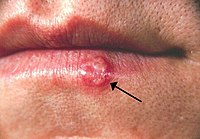
Photo from wikipedia
Background: Smoking is a risk factor for primary Raynaud’s phenomenon and, in patients with systemic sclerosis (SSc), has detrimental effects on the intensity of peripheral microangiopathy(1). Two studies on SSc… Click to show full abstract
Background: Smoking is a risk factor for primary Raynaud’s phenomenon and, in patients with systemic sclerosis (SSc), has detrimental effects on the intensity of peripheral microangiopathy(1). Two studies on SSc observed a lower prevalence of anti-topoisomerase I antibodies (ATA) in ever-smokers compared to never smokers(2,3), but little is known about how the effect of smoking on autoantibody status differs in male and female patients. Objectives: The aim of our study was to evaluate, in a cohort of SSc patients, the influence of smoking on nailfold videocapillaroscopy (NVC) patterns and autoantibody positivity, comparing findings between men and women. Methods: We included 361 adult patients (279 women and 82 men) with SSc. At baseline NVC was performed and microvascular damage was qualitatively assessed based on normal findings, aspecific/secondary pattern, or distinct “early”, “active”, or “late” scleroderma patterns. Information about smoking status was collected, but data regarding duration and intensity were not available for all individuals, so patients were categorized as never smokers or ever smokers. The presence of SSc-specific ATA, anti-centromere (ACA), and anti-RNA polymerase III (ARA) antibodies was investigated at baseline. Chi-square was used to compare proportions and significance level was set at 0.05. Results: No significant difference was observed in the qualitative assessment of microangiopathy between ever smokers and never smokers, nor in autoantibody positivity. Scleroderma patterns early, active, and late, were respectively present in 12%, 44% and 21% of ever-smokers, and 9%, 48%, and 29% of never-smokers. Equal proportions of NVC patterns were found also in the gender-based sub-cohorts. Regarding autoantibodies, 27% of women who never smoked were ATA positive compared to 11% of ever smokers (p<0.001), while the opposite trend was observed in men, although not reaching statistical significance possibly due to the relatively small size of the male cohort. Conclusion: In our large cohort of SSc patients, microangiopathy was not influenced by smoking status in male or female patients. The prevalence of ATA was, albeit not significantly, lower in ever smokers. Our finding is in accordance with previous studies(2,3), but it is worth noting that this disparity is largely contributed by the statistically significant higher frequency of ATA positivity in women who never smoked, compared to ever smokers. References [1] Hudson M, et al. Cigarette smoking in patients with systemic sclerosis. Arthritis Rheum 2011 Jan;63(1):230-8 [2] Chaudhary P, et al. Cigarette smoking is not a risk factor for systemic sclerosis. Arthritis Rheum 2011 Oct;63(10):3098-102 [3] Jaeger VK et al. Brief Report: Smoking in Systemic Sclerosis: A Longitudinal European Scleroderma Trials and Research Group Study. Arthritis Rheumatol 2018 Nov;70(11):1829-1834Table 1 microangiopathy pattern and autoantibody positivity in ever smokers and never smokers in all SSc patients and in gender-based sub-cohorts. ATA: anti-topoisomerase I, ACA: anti-centromere, ARA: anti-RNA polymerase III, NVC: nailfold videocapillaroscopy. Disclosure of Interests: Jacopo Ciaffi: None declared, Nina van Leeuwen: None declared, Jeska de Vries-Bouwstra: None declared, Thomas Huizinga Consultant for: Merck, UCB, Bristol Myers Squibb, Biotest AG, Pfizer, GSK, Novartis, Roche, Sanofi-Aventis, Abbott, Crescendo Bioscience Inc., Nycomed, Boeringher, Takeda, Zydus, Epirus, Eli Lilly
Journal Title: Annals of the Rheumatic Diseases
Year Published: 2019
Link to full text (if available)
Share on Social Media: Sign Up to like & get
recommendations!